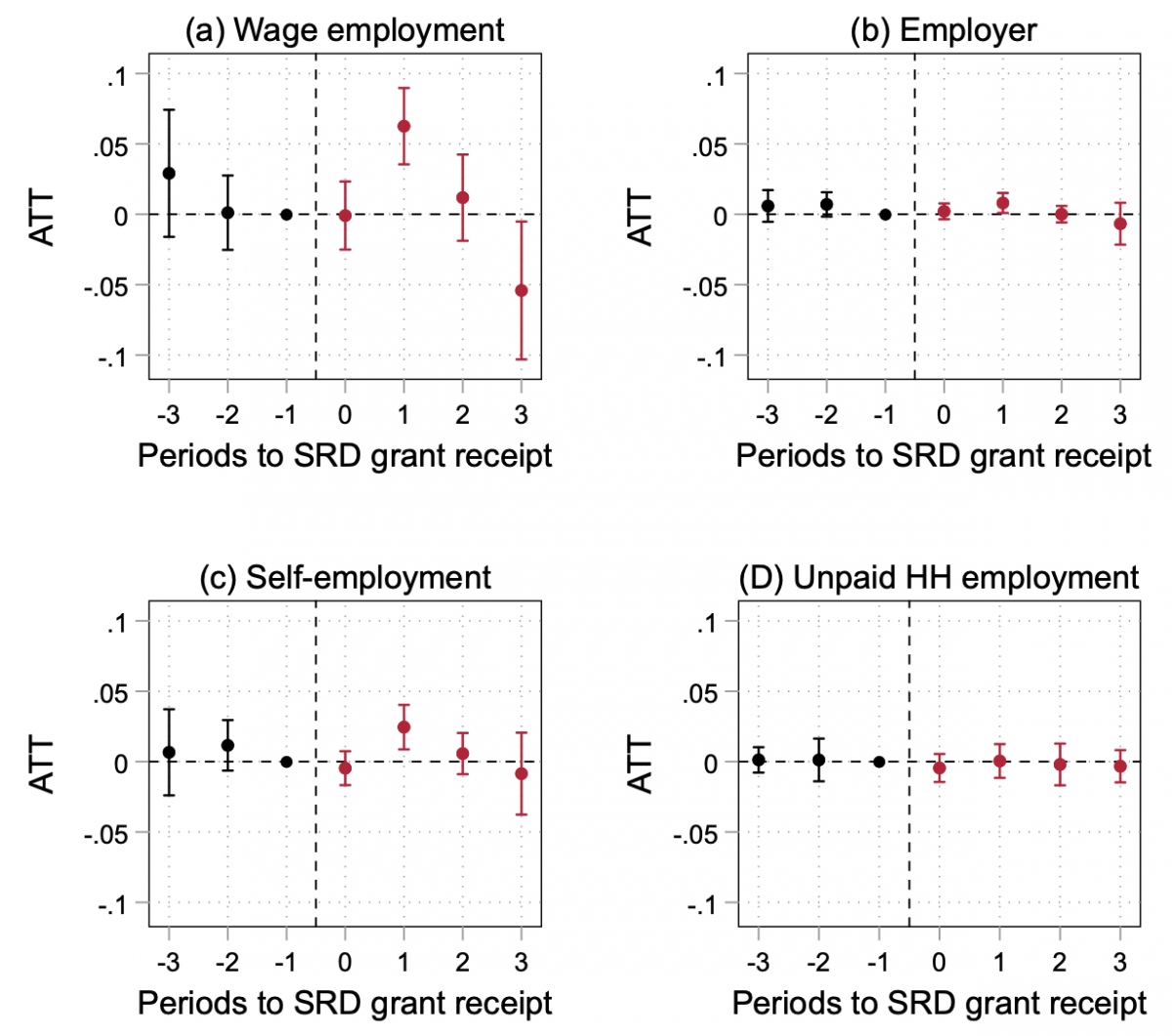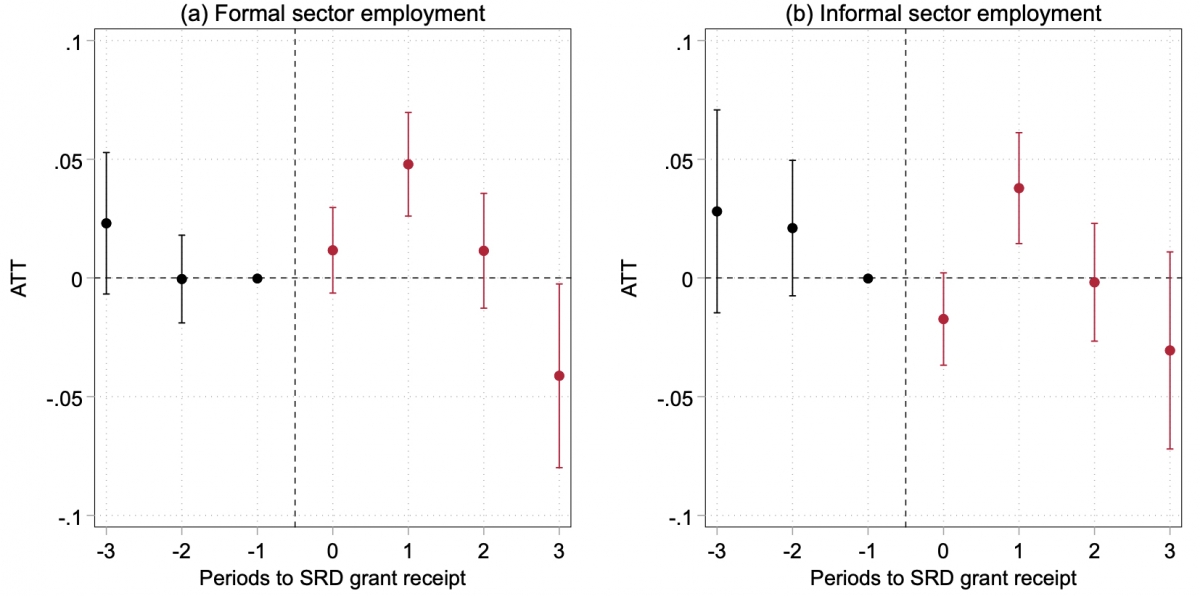Special Covid-19 grants not only provided income relief: they also improved labour-market outcomes
Introduction
Extremely high unemployment has persistently plagued the South African economy. The unprecedented crisis caused by the COVID-19 pandemic only aggravated this. However, despite the far-reaching and progressive nature of the country’s social protection system, prior to the pandemic there was a dearth of state-provided income support to the working-age population. In this light, the government’s introduction of the COVID-19 Social Relief of Distress (SRD) grant – targeted at the unemployed – played an important role in addressing this hole in the country’s safety net in its response to the pandemic. The transfer provided income support to millions of vulnerable, previously unreached individuals in a relatively short space of time, as highlighted in some of our previous work.
Importantly, the COVID-19 SRD grant is the first in South Africa’s history to make explicit use of a labour-market criterion to determine eligibility. As such, one can arguably consider the grant a ‘labour market vulnerability transfer.’ While the grant’s primary aim was to provide income support to a vulnerable population, it is plausible that it also played an important role in aiding economic recovery through its effects on labour-market behaviour. Indeed, anti-poverty programmes and economic recovery policy need not be mutually exclusive. Until now, however, there has been no causal evidence on the effects of the grant on any outcome, and it is plausible that such effects may vary from those of pre-existing grants that are characterised by markedly different eligibility criteria.
How to establish causality
There’s a reason for this lack of causal evidence: establishing a causal effect is difficult. Without a randomized experiment, simply comparing outcomes between grant recipients and non-recipients and attributing any difference to grant receipt is not a credible way of conducting causal inference. This is because recipients and non-recipients differ in many ways other than just receipt (what we microeconomists call ‘selection’). For instance, SRD recipients are more likely to be young and have less than a complete secondary-level education. In this case, these differences in themselves may explain any difference in outcomes between recipients and non-recipients, rather than receipt itself. What if we alternatively compare the same group with itself over time; that is, the outcomes of recipients from before the grant with after it was introduced? While this takes care of the ‘selection’ problem described above, it would also be inadequate given that many factors other than grant receipt may influence outcomes over time.
So how might one isolate the causal effect of the SRD grant? In our new working paper, we seek to explain this by providing the first set of causal estimates on labour-market outcomes. To do so, we adopt one of the most popular causal inference methods used by quantitative social scientists that actually predates randomized experiments: a Difference-in-Differences (DiD) approach. Simply put, this method combines the between-group and between-period comparisons described above to estimate what is referred to as counterfactuals – that is, the average outcomes of SRD grant recipients if the SRD had not been introduced. Comparing average actual outcomes to the counterfactuals then allows us to arrive at average causal effects. We use this ‘natural experiment’ method on representative, individual-level labour-force data (StatsSA’s QLFS), which follows the same group of people for the whole of 2020 and the beginning of 2021. Given the characteristics of our specific data and design, we use an adapted approach recently developed by Callaway and Sant’Anna (2021), which has been shown to yield far more reliable results than conventional DiD designs in this context.
We focus on effects on three outcomes in particular: the probabilities of job search, trying to start a business, and employment. We also examine whether employment effects vary by sectoral formality (formal versus informal) and type of employment relationship (for instance, working for pay or being self-employed). For each of these outcomes, we estimate overall average effects as well as ‘cumulative’ effects (how effects vary depending on how long the grant has been received). These latter effects allow us to gain an understanding of effect dynamics over time, and hence speak to the grant as either a transitory or more permanent income shock.
Results
Overall, despite the relatively small size of the transfer, we find robust evidence that the grant had notable, albeit small, labour-market effects. Our preferred models suggest that receipt of the grant increased the probability of employment by just under 3 percentage points – an effect that is robust to several sensitivity tests.[1] However, we find only a marginally significant and relatively small effect (a 1.2 percentage point increase) on the probability of trying to start a business, and no effect on the probability of engaging in job search. Regarding this latter finding, it should be noted that this doesn’t necessarily imply the SRD increased chances of finding work without looking for it. Rather, the grant may have had other effects on job search behaviour on the intensive-margin (for instance, how one looks for work) that we have not examined here.
Considering effect dynamics, as shown in panel (c) of Figure 1 below, we find that the employment effect of SRD grant receipt was initially large but decreased the longer recipients were exposed to the grant. While the “on-impact” effect (at ) is statistically zero, receiving the grant for one additional quarter raises the likelihood of getting a job to 8.6 percentage points, but thereafter the effect dissipates and approaches zero. After one complete year of receipt, the estimate even becomes negative. However, it is not statistically different from zero, possibly because of the relatively small sample size of individuals we observe over such a long period in the data. As such, while it appears that employment effects dissipate with time, we cannot confidently conclude that they change in sign (from positive to negative). We continue to find no robust evidence of any job search effects, while the effect on the probability of trying to start a business remains small.
Figure 1: Event study treatment effect estimates of COVID-19 SRD grant receipt, by outcome[2]

Source: Bhorat, Köhler, and de Villiers (2023).
When we explore how the above employment effects vary by type of employment relationship, we find that the positive employment effect was driven by a positive effect on the probability of wage employment (that is, working for someone for pay). Our preferred model suggests that, overall, receipt of the grant increased the average wage employment probability by 2.3 percentage points. While the average effect on self-employment is still positive, it is very small in magnitude (less than 1 percentage point) and only marginally statistically significant. We find no evidence of any average effect on the probabilities of becoming an employer or unpaid household worker helping in a family business. Considering effect dynamics again, as shown in Figure 2, we again find no evidence of an “on-impact” effect for any outcome, but after one additional quarter of receipt, we observe positive effects on all outcomes apart from the probability of becoming an unpaid household worker. Importantly however, considering the magnitudes of effects, it is clear that the overall positive employment effect was driven almost entirely by a positive effect on wage employment.
Figure 2: Event study treatment effect estimates of COVID-19 SRD grant receipt, by employment type

Source: Bhorat, Köhler, and de Villiers (2023).
Finally, we explore how the above employment effects vary by the sector of employment. Overall, we find that a positive effect on formal sector employment drove the overall employment effect. Specifically, we estimate that receipt of the grant increased the average formal sector employment probability by 2.2 percentage points. In contrast, we do not find strong evidence of any effect on informal sector employment on average. However, considering how effects vary by duration of receipt as shown in Figure 3 below, while we again find no evidence of any “on-impact” effect of receipt of the grant for either of the two outcomes, after one additional quarter of receipt the effect rises to approximately 5 and 4 percentage points for formal and informal sector employment probabilities, respectively, and thereafter reduce in magnitude.
Figure 3: Event study treatment effect estimates of COVID-19 SRD grant receipt, by employment sector

Source: Bhorat, Köhler, and de Villiers (2023).
Conclusion
Until now, there has been no causal evidence of the effects of receipt of the COVID-19 SRD grant on employment outcomes. In our recently released working paper, we attempt to fill this gap and provide evidence of effects on several individual-level labour market outcomes by exploiting a ‘natural experiment’ on representative and panel labour-force data. In doing so, we sought to examine whether the SRD both provided income relief as well as contributing towards the recovery of the South African labour market.
Overall, we find robust evidence that the COVID-19 SRD grant had a small yet significant impact on key labour market outcomes. We find that the grant increased the probability of employment, and that these employment effects were driven by effects on wage employment in the formal sector. Importantly, employment effects all vary by duration of receipt, with larger effects estimated in the short term reducing steadily to zero with additional exposure to the grant. Importantly, this suggests stronger labour-market benefits of the grant, at least in its current form, in the short term. We also find some evidence that the grant increased the probability of trying to start a business, but no robust evidence of an effect on engaging in job search. We’re working on furthering our analysis to identify the underlying mechanisms behind these effects.
It can thus be said that the grant served a multipurpose role in both providing income relief to a large group of vulnerable, previously unreached individuals as well as enabling a path towards more favourable labour-market outcomes. While the effects we estimate are small, they make it clear that the grant did not deter participation in the labour market but rather enabled it, which is contrary to what many believe. Finally, it can also be argued that the grant has thus acted as both a passive labour market policy (which provides income support to the unemployed) and active labour market policy (which seeks to remove barriers to labour market participation and good jobs), despite not being designed to do so. While other factors such as broader macroeconomic effects and fiscal sustainability also need to be considered, our results suggest that cash transfers may be one avenue to improving the functioning of the South African labour market, possibly in combination with other more traditional active labour market policy interventions.
Notes
This article is based on:
Bhorat, H., Köhler, T. and de Villiers, D. (2023). Can Cash Transfers to the Unemployed Support Economic Activity? Evidence from South Africa. Development Policy Research Unit Working Paper 202301. DPRU, University of Cape Town. Available here: https://tinyurl.com/dpruwp202301.
Originally published as: Bhorat, H., Köhler, T. and de Villiers, D. 2023. ‘Can Cash Transfers to the Unemployed Support Economic Activity? Evidence from South Africa.’ Agence française de développement Research Paper No. 278. Available here: https://tinyurl.com/afdsrd2023.
[1] Simply put, these tests seek to ensure that our approach to estimating a causal effect is valid. For example, we use different methods of making recipients and non-recipients in our sample more similar in terms of demographic and socioeconomic characteristics, and compare how our effect estimates change depending on whether our approach compares the outcomes of individuals who received the grant with those who those who hadn’t yet received the grant by a given period, or who had never received the grant during the whole period.
[2] ATT refers to Average Treatment Effect on the Treated.
Download article
Post a commentary
This comment facility is intended for considered commentaries to stimulate substantive debate. Comments may be screened by an editor before they appear online. To comment one must be registered and logged in.
This comment facility is intended for considered commentaries to stimulate substantive debate. Comments may be screened by an editor before they appear online. Please view "Submitting a commentary" for more information.
